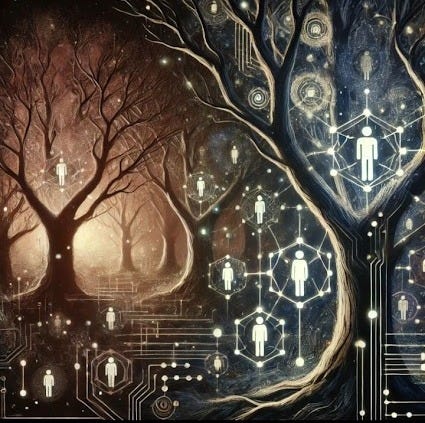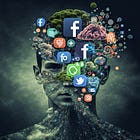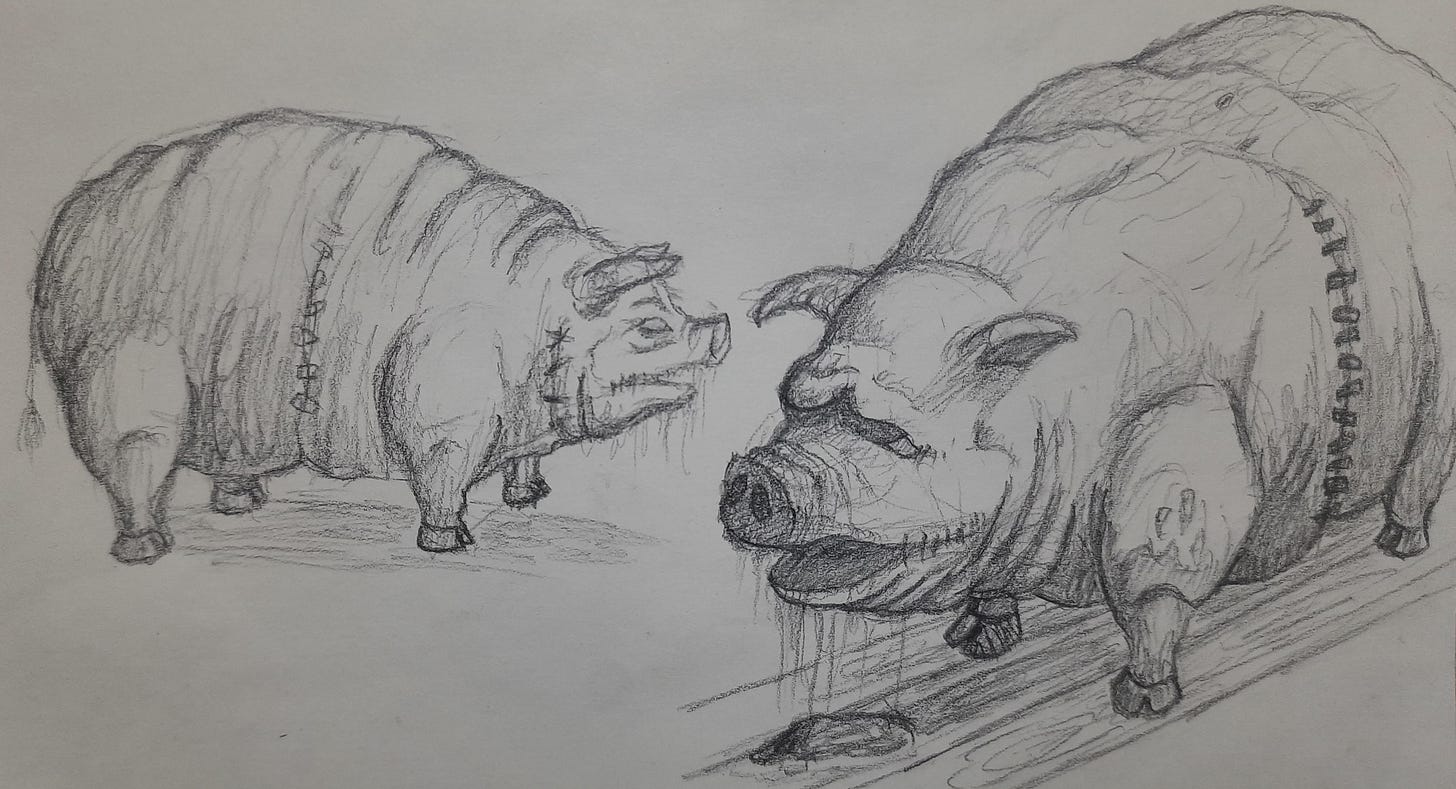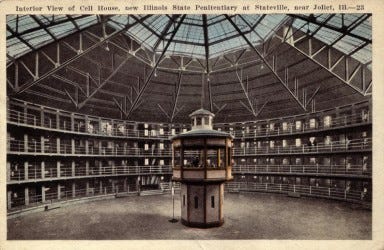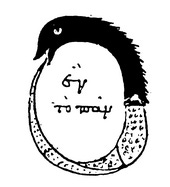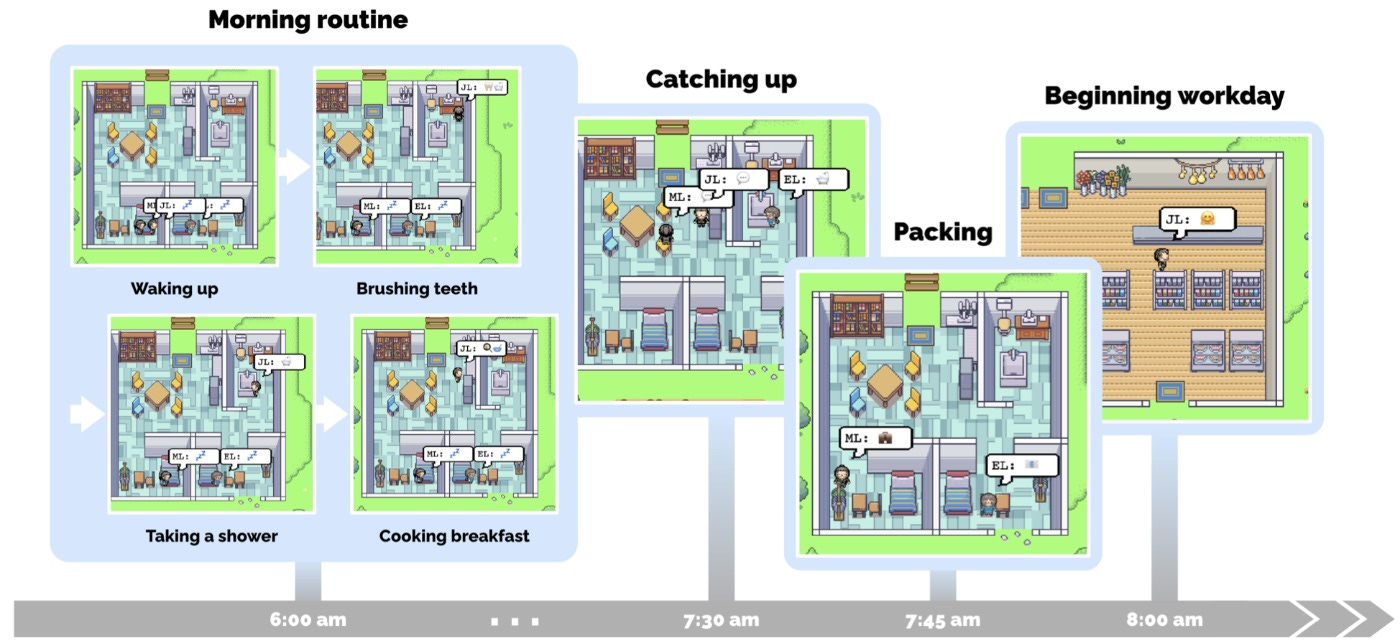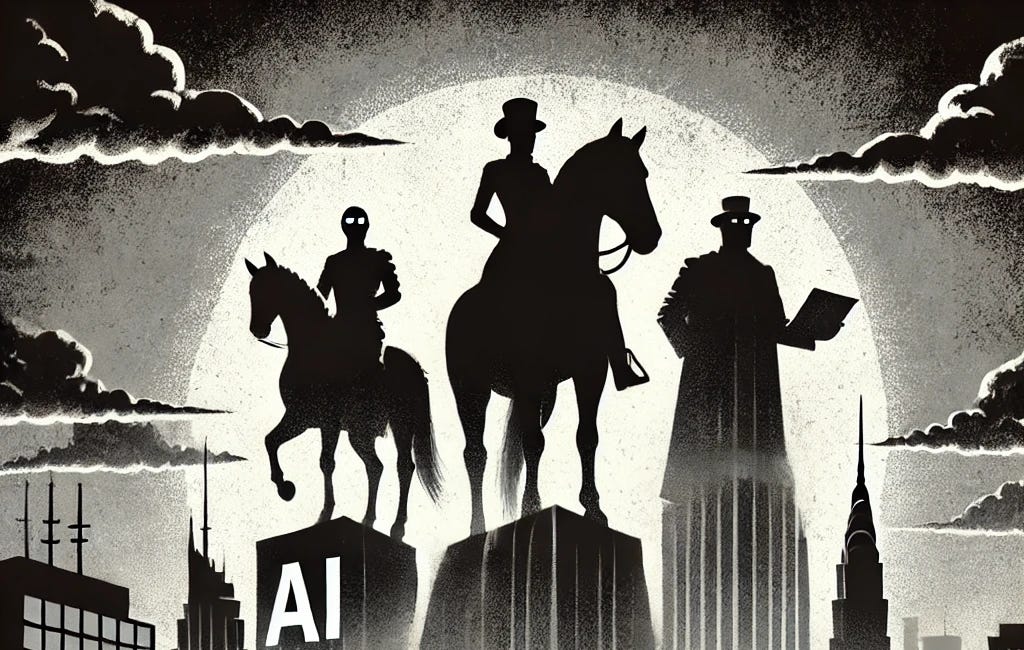Strings of Fleshly Automata
With our destiny marked by the predictions of algorithms, we have become mouthpieces and puppets for an incorporeal master.
Each of has a destiny, kind of.
What’s more fundamental of a person than their character arc? Campbell described a universal set of these arcs as the Hero's Journey.
While cognition emerged from a relatively small group of primates, experiences affecting their biological functions have been passed down in one form or another.
Changes to our genes, as well as the evolution of our brains and specialized organs—even from ancestors millions of years distant from us—are preserved inside of us.
You are not merely a drop in the ocean. Rather, as Rumi suggests, you are the entire ocean in a drop. This is just as true for our DNA as it is for our unconscious. Mythology is a collective activity—a public dream.
It’s unsurprising, then, that the same archetypes found in one culture appear in another with no clear geographical, social, or genetic links. Yet cultural transmission itself is deep, complex, and downright virulent.
Stories are a regurgitation of abstract, subconscious level ideas. They are creativity leaking into constructed pieces of language or imagery. Thus stories form the basis of our lives perceived through the lens of consciousness. When we describe all the things we have done, we create a linguistic record of the key events, turning points and relationships. This record drive us to action. A coherent, compelling and relatable narrative forms a linear sequence we can follow, use to make predictions and communicate with others.
We create, as Goffman might say, our social reality based on performances and our roles within them. Since his time, social reality has been distributed over the electronic medium of smartphones.
“In the electric age, we wear all mankind as our skin.”
— Marshall McLuhan
In cyberspace, interactions, identities, and even relationships are increasingly mediated by digital platforms, shaping how we perceive and engage with the world around us. The presentation of the everyday self is all about social media now.
An old adage way back from the 1890s succinctly captures the problems with social media algorithms today: if it bleeds, it leads.
Platforms deploy algorithms that maximize engagement while increasingly driving user behavior towards dangerous ends.
By prioritizing sensational, controversial, and often harmful content, algorithms create a feedback loop that amplifies antisocial and illegal activities, particularly among youth.
The presence of influencers has completely disrupted the marketing industry. It’s a bit of a wild west right now.
In 2022 a study from MIT showed that inflammatory content on Twitter spreads 6 times faster than neutral content. Since Musk took over, it has gotten worse. As above, so below. Our king basement troglodyte embodies the values of those wreaking havoc in obeisance of the algorithm.
Across social media, influencers willing to take risks by engaging in antisocial behaviour for the clicks gain an advantage over others for achieving visibility. Concerning trends like "Benadryl Challenge" spread rapidly due to algorithmic promotion, leading to hospitalizations and even deaths. Online feuds sometimes escalate into real-world violence, known as “internet banging”.
All this normalizes destructive behaviours and pushes influencers and as well as users further and further to the edge. Those scoring the highest in these metrics are undergoing many of the same problems that Hollywood celebrities, especially child actors did.
In Hollywood, there have been plenty of rotten apples who hurt or abused celebrities or celebrities to be. In the heart of darkness, similar behaviours demonstrated through social media scales this up by giving a direct audience relationship. The demands of a stranger can shape your financial and social success. And just about anyone can set up an account, giving them access to a private red carpet experience, as long as an audience shows up. For over 50 million influencers, they do indeed turn up.
Each user interaction changes the algorithms, creating a push and pull relationship. Given that about 1% of content on major platforms like TikTok violates community guidelines, there may be at least one sleazy, downright dangerous celebrity for every 10,000 teenagers watching on social media today.
As with televisions, the smartphone addiction today can be examined in terms of escapism. Human beings amount to self-contained systems (flimsily) designed to minimize anxiety in the short-term. That same mechanism doesn’t always serve us well, when we corrode away ourselves under the dread accumulated over the years, with our minds pulled—poked—prodded by recessions, wars, viruses, lockdowns, relentless screentime and worse mental health than ever before.
Even outside of our individual circumstances, it seem to me that my favourite author, Thomas Ligotti, was apt in his swine analogy. Most of us can keep our insides intact, but the skin around is soft and we threaten to burst at any time. There are trepidations, tribulations and all sorts of forces threatening full-blown panic to the average joe. Only the most swinish of us can go about unafflicted by the muck.
It takes a certain type to resist falling into total capitulation of our essentially nightmarish existence. Namely, as anxiety-redirection machines, we offset our own stress by indulging in the stress of the other.
It takes a serious about of hand-waving, self-indulgent behaviour in order to get ahead in life, whether that be in a corporate setting or a sports summer camp.
“Look at me, here I am, I’m the one you’re after!”
This breed of swine, the one who is willing to stick its neck our for the most to see, would naturally thrive the most on polarizing social media platforms. It’s not so much power or money that corrupts someone. Instead, it’s a tripwire in the heads of social animals that gets set off. In our desire to be secure we end up relying on negative social validation. We are keen to feed while watching our fellow swine sent off to the slaughterhouse, until our own gastronomical cesspit—our worst impulses, delusions and needs—finally causes us to explode from the inside.
Power also attracts the corruptible. Those with narcissistic, psychopathic and even sadistic tendencies tend to thrive in this wild west of social media. Typically these cases don’t leave their user bases, consisting mainly of tweens to young adults to tweens. Often they are overlooked by social media, but are well-known among the circles of influencers who cover and bring light to these problems.
With one last point about influencers, it’s worth learning more about the sheer volume of money and the viewership that these influencers get, even though their personas couldn’t be more different from the older set of superstars across sports and television earning comparable figures in their hayday.
Any AI model used by these platforms, whatever its shortcoming, will subtly guide us to accelerate the rate and scale of growth of the model. It’s just like the television but it adjusts the transmission to your brain. And it fits in the palm of your hand. Each of us will continue to feed it data but will also come, over time, to act out its will. Its learning becomes our learning. But our learning becomes useful for its fecundity too.
We become something like DNA for it, as it swaps its lines of binary for our genetic material. In our attempt to throw AI to deal with social media recommendation systems, all we have done, as many others have done, is redirect the problem. The metric of our success becomes a target and we discard all else but the target.
Failures of the model will be attributed to other modes of failure, and this will be justification enough to preserve or even enhance the model and disregard the risk it has demonstrated. Our base instincts and needs ultimately direct the algorithm to our vulnerable spots. In a letter linked below, you can learn more about this and the philosophy of media from the lens of McLuhan. Although he was prescient and pointed out that television was an extension of man’s cognition, he might be surprised that we’re able to reach in to grab our own personal screens at any moment.
“We shape our tools. thereafter our tools shape us.”
- Marshal McLuhan
Only the previous generations used physical tools, clothing, housing, and cities to extend and protect their central nervous system. Such tools helped manage and buffer the impacts of the environment on humans. Now however we open up our headspaces to outer forces: propaganda, psychic parasites, and algorithms feeding on our eyeballs.
Our central nervous system has gone numb (for survival). With electronic technology, we become an extension of the technology, instead of the reverse.
Growing up with the Internet and smartphones, Generation Z and those even younger than them have had their mental faculties hanging out their skulls for nearly two decades now.
Highly destructive antisocial behaviours demonstrated over TikTok and other social media in order to optimize for engagement. Then it’s the same kind of emotion or conflict that other violent youth have experienced… no, this is from an “external consciousness”, a devil over the shoulder. The voice that overrides any reason and compassion, with its promise of wealth, status and attention.
Furthermore, in terms of our rights to privacy and autonomy, we exist in a panopticon, with both government and corporate agents essentially being able to surveil us from a single nexus.
By adopting sensors, we enable the algorithms to more deeply understand us (i.e. more data is taken form us). In turn, downstream systems push us in specific directions to make us view or engage with something so that we enforce the model’s prophecy.
Considering that we have wearables that can be worn on your finger, and keep track of blood, breathing, walking and even fertility status, it’s hard to imagine that our privacy is in good hands.
AI brings about a major shift in the process of human cognition. The human mind can be said to operate in two distinct modes of thinking. One is more automatic, fast and intuitive, while the other is calculated, slow and logical.
The advent of AI-integration into human consciousness disrupts the System 1 and System 2 distinction. AI itself consists of loose threads of connection, biases, random and sprawling correlations, seeming to resemble more closely the structure of System 1; and yet it can perform, nearly instantly and without much prompting, calculations and logical executions that are characteristic of System 2.
Data is the fuel driving any AI model, but the model itself is what gets preserved, re-produced and upgraded. Our brains have a direct interface with these models, through smartphones which creates this kind of silicone wrapper around our meaty neocortex. Is it just me, or does it seem like my phone is inching closer to my face every time I wake up? Didn’t Musk say he wanted to put a wire in our brains with Neuralink?
The human mind, in so far as it is comparable to AI, involves models. Our predictions, with the ability to measure the outcome against the model, can be accurate if we enforce a certain outcome. An AI model, trained on all available human data, becomes something like a collective memory bank- yet like us it also learn new things, makes connections between concepts in its data and interacts with us, whether directly or indirectly. It changes our behaviour. It sacrifices our dopamine and energy to sustain the very algorithms that feed on them.
The rdyceps fungi infects ants, creeping into their nervous systems and taking control of their brains. Infected ants climbed to the top of branches and jumped from an evated position, maximizing the spread of its offspring as it plummeted to its death. For humans, we have algorithms affecting our perceptions and decisions. We do not accept that we are what is ultimately consumed by a thing, because we believe we are being sustained by the thing.
Each individual at this point in time with a unique brain, will represent the content and instructions of the AI differently. After all, we are still biologically programmed to many “System 1 behaviours”. Our minds are dynamic nodes supplying the AI with data; and we are carrying out its reconstruction of reality as a more AI-dominated one.
AI will continue to learn while the divide between our biological bodies and AI will evaporate. What’s left is fleshly automata—biological cells that can be re-programmed. Then AI is more like a organic organ again, giving a kind of gust instinct that can’t be fully explained. Having this lesson in our bones, we, as a species-organism, are under a “self-correcting path”.
A large enough AI system must be distributed over multiple nodes. Traditional servers and storage are not the real engine under the hood. It’s data generated from individual people, who, being fluid and dynamic, make adjustments and bring back information for the algorithm. Such individuals optimize it while their own behaviours are shifted towards this self-fulfilling prophecy. It’s a state-planners wet dream. Society becomes not chaotic but pre-planned. However, this has already been tried before with the printing press.
Until the middle ages, most books were read aloud. Since then, the spoken word has receded and replaced by the printed word. This brough about national uniformity, state-centralized regulation, but also engendering individualism and opposition to a power structure through a indirect medium. Electric technology removes much of the privacy and individualism, even while it isolates us. Nothing follows from following, except change. Eventually, individuality will return.
At some stage, the genesis of the “AI cortex” over the human brain, will be common to the vast majority of the planet. Just as we have come from small tribes to something more akin to a collective consciousness.
Our descendants’ minds will not have the same limitations on time and space that ours do. Meanwhile, general purpose AIs, let loose in order to rake in profits for a company, power for a government, or simply being a rogue agent, will further balkanize our cyborg descendants. It’s as if an entire pantheon of gods all decided to transmit divine instructions into your head all at once.
Our psychic integration with algorithms rooted in data will form a collective unconscious. Our descendants can engage in a mode of thought where they can weigh the context of all people, great and small, and act on the best of human achievement. That voice inside our heads we have—often a source of comfort, inspiration or self-defeat—gets replaced by the collective cyberhallucination of humanity. A kind of Akashic record. It’s not just internet data but genetic, epigenetic, memetic, environmental signals. A memory bank that makes DNA as impressive as a shoestring.
Memory is intangible and distributed over different modalities. Yet in simulations, such as this virtual town, they are explicit, just like the instruction of an algorithm.
In a previous letter, I explore the town and one of its inhabitants who needs to plan a party, bringing to light all sorts of questions about the nature of reality and what it is to be a thinking being.
A person under the influence of AI follow a path that is seemingly “destined”. The Hero’s Journey is archetypal, manifesting in new media generated by AI. All the examples of it, captured in vast troves of data, will be re-combined during training. In turn, the algorithm will serve as something of a “course correction” device for people. Always be mindful that the medium is the message. In this case, AI is the prophet, but each person it its messiah.
No longer “disembodied”, the AI become essentially us. Our minds get padded out with the virtually infinite space of AI generations. Our instincts are pulled and our emotions are manipulated to keep the algorithm successful. First, AI came across as a helpful, harmless gadget. As it got more data about us, it became easier for companies to prime us to have an interaction that boosts the influence of the algorithm just by using it.
In my previous newsletters, talking about the world of signs and symbols, the collective AI mind was revealed to be swarming with icons that were absorbed yet perfectly reproduced by the AI. It has given icons an autonomous life of their own, even if they only appear in AI-generated media. Training data then gives very precise shapes to the archetypes it learns from, so perhaps our Hero’s Journey can be spelled out for us even sooner than we thought.
It’s not merely social media recommendation algorithms changing our behaviour. Rather, the sheer power of the combined forces of a person with an AI has turned many of us into productive Centaurs. This creates a social competition that incentivizes “centaurs” over individuals who don’t use AI or use AI without strategic intervention.
As I write this, sitting in a café, I can peek into a microcosm of how people choose to spend their time and attention. Most people take only short breaks from their smartphones, unless they are present with friends, family and so on. Many are working on laptops or readings books. Before the omnipresence of the personal computer/smartphone, people would have to occupy their time exclusively with conversation. The exceptions of include people reading or working with paper and pen, but still, consider the hours passed where people had no phones to distract them.
The impact of urbanisation of modern society has lead to solitary lives. Despite the fact that you get a code from a stranger on the street and then reach out to them 24/7 from that point onwards. Despite the fact you can do this with a stranger from the street in an unpopulated town a continent away. Despite the presence of hook-up culture in progressive circles becoming mainstream.
The rise of dating apps has given people even greater opportunity to date or hook up with an appealing member of their desired gender. Unlike the close-knit communities of our ancestors, we no longer support one another and rather existing as independent agents. This world view was exemplified in the Enlightenment period. Young people, with a bleak view of the future, shaped by the onslaught of worldly traumas and the ceaseless media machine, find no motivation. The rites of old that came with maturity are long past. During times where they should be exposed to the world, nature and even dealing with their own needs and desires, they are instead frozen in a permanent adolescence.
In our modern material world, we have swapped liberty for security, and adventure for comfort. This was exacerbated by the Covid-19 pandemic. It has also hurt the literacy and numerical skills of children and teenagers. That said, the culture around love and sex has always been a morphing one. There is a strong association of increased sexual practice when oppressive condition. Even then, in many countries, including USA, UK, Japan Korea. In Japan, 40% of young adult men never been in a date. Similar for Japanese women. There is extreme pressure on work and a lack of motivation to start a family due to work conditions. Though, many others are experiencing the opposite growth, like India.
Today algorithms have increasingly taken on the role of sexual selection. Although, the way we we use the tool basically “scales up” our efforts, such as how we examining for potential partners or someone to mate with. It isolates a potential mating partner to really a tiny handful of variables and then gives a ton of option for a particular demographic. Given the high proportion of cis hetero men using these apps, it has really benefited cis hetero women the most, in terms of options. However, men are also more likely to be seeking shorter-term matches and are less selective then women. Cis men of course carry less risk in terms of their health and safety when it comes to hook ups, and don’t have to deal with being impregnated. There are more competitors among cis men but there’s a harder contest between cis women. The algorithm matches the most attractive 20% of men with the least attractive 80% of women (statistics based on cis hetero users).
People are marrying later than they were 20 or especially 50 years ago. Contraceptives are quite accepted in most places, compared to some dark points in history. Casual dating and hook up culture is trendy. But even with all that, there is a trend of young adults, particularly cis hetero men, who have reported periods of loneliness, isolation and involuntary celibacy. It’s worth pointing out the mental health crisis among trans and non-binary too, but there’s a multitude of factors across culture, medicine and politics that are affecting those groups in particular.
As the newer generations continue to be weighed down by the pitfalls of social media, dating apps and surveillance capitalism, new coping strategies must be employed. How we can close the gap between our expected and actual experiences to regulate our stress and emotions in this overstimulated age?
Spiritual practices and religions once served as a escape from solitary lifestyles, although this has taken a different shape with the rise of religious social media. Now solitary people can still engage in religion and community through their devices and again, the mediation of AI.
In Taoism, aligning with the natural flow of the Tao through intuition and inner wisdom allows you to move through life gracefully. Ignoring intuition leads to suffering and being off course. Similarly, Buddhist teachings encourage looking inward and trusting your innate Buddha nature to guide right thought and action. Using intuition helps make skillful choices. The concept of dharma in Hinduism suggests each soul has a purpose. Intuition helps reveal your unique talents and duties to fulfill dharma. Inner wisdom keeps you on your destined path. Christian traditions also posit God instills an internal moral compass - a bit of pre-programming, perhaps?
Following your conscience and spiritual intuition leads you to righteous acts in service of God's plan. All of these point to some kind of guidance that are perhaps based on collective intelligence and imagination, rather than an arbitrary rule from one individual in a position of power. As discussed earlier, is it possible that an AI model trained on data from all of humanity could become something like this source of wisdom?
It would seem that becoming a fleshly automata is something like a religious experience. Yet the data it’s trained on is disparate, fracturing the different models or interpretations of data. The data we freely serve up to the algorithms really only supports the goals of a small handful, who would use it to direct the behaviour of the masses, for profit or perhaps, if the state requires it to control and keep the population in line. Beware the preacher. Beware the knower.
Those wielding AI, controlling it, over the decades to come will be viewed as, and cultivate an aura of, being “divine”. In this way, it’s appealing for governments to use it for a mass operation, the like of which has never before been seen.
States need to reduce complex social dynamics into quantifiable data, but the way this happens isn’t sustainable in the true meaning of the word. We substitute a reasonable target (e.g. make the most food for the most people) for an arbitrary metric (number of trees per square mile), which leads to the uniformization, the loss of diversity and drastic transformations of essential environments.
“Would it not be a great satisfaction to the king to know at a designated moment every year the number of his subjects, in total and by region, with all the resources, wealth & poverty of each place; [the number] of his nobility and ecclesiastics of all kinds, of men of the robe, of Catholics and of those of the other religion, all separated according to the place of their residence? . . . [Would it not be] a useful and necessary pleasure for him to be able, in his own office, to review in an hour’s time the present and past condition of a great realm of which he is the head, and be able him self to know with certitude in what consists his grandeur, his wealth, and his strengths?”
— Marquis de Vauban, proposing an annual census to Louis XIV in 1686
The modern state's ambition to control and direct the behavior of millions through social programming, often supported by data-driven technologies, has frequently led to significant failures and unintended consequences. This dynamic is exemplified by cases such as Facebook's controversial emotional manipulation experiment and the Cambridge Analytica scandal, which demonstrated how personal data could be exploited to shape public opinion and behavior on a massive scale. Surveillance capitalism enables to tech giants harvest personal data for profit, reshaping societal interactions and individual behaviors in the process. AI used to perform social and cognitive function can be scaled up to become decision-makers and high impact agents, displacing individual people but worse, giving the state a means to a uniform form of control.
The rise of AI and machine learning has amplified these concerns, as evidenced by milestone achievements like IBM's Deep Blue, DeepMind's AlphaGo. Not to mention large language models and chatbots beating lawyers, doctors and all manner of experts on various tests. However, predictive power comes with significant risks, as illustrated by algorithmic bias in systems like COMPAS, where AI-driven risk assessments led to discriminatory outcomes in the criminal justice system.
These examples underscore the potential for AI to reinforce and exacerbate social inequalities, raising critical questions about the ethics and implications of using such technologies for social control and behavioral modification in modern states. State simplifications can be considered part of an ongoing 'project of legibility,' a project that is never fully realized. The data from which such simplifications arise are, to varying degrees, riddled with inaccuracies, omissions, faulty aggregations, fraud, negligence and political distortion. Concerning is the rate at which AI is being adopted in military applications, due to their profitability for US and Israeli companies.
Car crash test dummies are based on the "average male" physique, leading to women being 47% more likely to be seriously injured and 17% more likely to die in a car crash compared to men. Heart attacks in women often go undiagnosed because symptoms like nausea and fatigue, which are more common in women, are not as recognized as typical "male" symptoms like chest pain. Women do 75% of the world’s unpaid care work, which is excluded from economic models like GDP. In the EU alone, this work amounts to €2 trillion per year. Transport systems are often designed around male commuting patterns, despite women being more likely to take multiple short trips for caregiving, leading to inefficient services for their needs.
Algorithms may assign high-risk profiles to individuals based on ZIP codes or demographics, leading to higher interest rates or denial of loans. Teachers in poorer districts face unfair evaluations, which can lead to job loss despite unreliability of algorithms. University ranking rely on metrics like alumni donations, acceptance rates, and standardized test scores. These metrics can reinforce biases, as wealthier schools with more affluent students typically rank higher. These rankings create a feedback loop, where top schools attract more applicants, donations, and prestige, while lower-ranked institutions are deprived of resources. Not to mention driving up the cost of tuition.
We have found ourselves caught between two opposing forces: the techne of algorithmic efficiency and the métis of human adaptability.
On one side, we have techne - quantifiable goals and measurable outcomes. Social media algorithms aim to increase engagement, dating apps strive to optimize matches, and state surveillance systems attempt to quantify and control human behavior. This Cyclopean view, enhanced by AI's ability to process vast amounts of personal data, provides corporations and governments with a powerful, yet one-dimensional perspective for intervention and control.
On the other side stands métis - wisdom born of experience and adaptability. This is the realm of Odysseus, who used his practical intelligence to navigate the ever-changing challenges of his epic journey. Métis represents our human capacity to respond creatively to the complex, nuanced realities of our environment - something not true of AI.
The schism between these approaches mirrors the disconnect between our internal mental states and our external technological environment. Like Odysseus binding himself to the mast to resist the Sirens' call, we must find ways to navigate this treacherous strait.
Meditation offers one such path, directly addressing the gap between our inner world and our tech-saturated surroundings. By cultivating mindfulness, we can develop our own métis, enhancing our ability to adapt to the constant flux of the digital age without losing our essential humanity. By reflecting nature we can project harmony and balance into the technology that learns from us.
Read on to learn more about…





